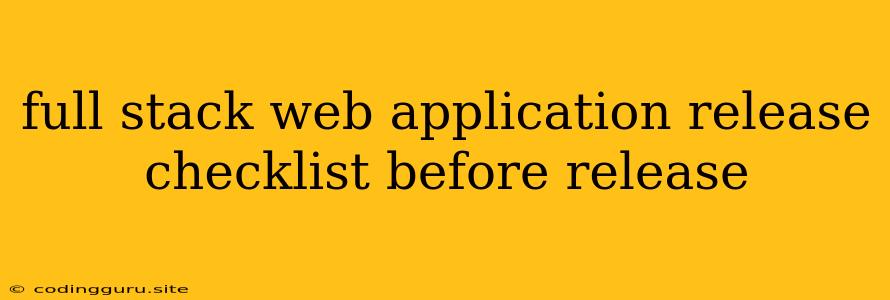Full Stack Web Application Release Checklist Before Release: A Comprehensive Guide
Releasing a full stack web application is a complex process that requires meticulous planning and execution to ensure a successful and smooth launch. To avoid unexpected issues and ensure a seamless user experience, a comprehensive checklist is crucial. This article provides a detailed checklist that addresses key areas of development, testing, deployment, and post-release monitoring to guide you through the entire release process.
Development Stage:
1. Code Review:
- Question: Have all code changes been thoroughly reviewed and approved by the development team?
- Tip: Code reviews help identify potential bugs, security vulnerabilities, and code style inconsistencies, improving code quality and maintainability.
2. Unit Tests:
- Question: Have all new features and changes been covered by comprehensive unit tests?
- Tip: Writing unit tests for each component of the application ensures that individual pieces function correctly and reduces the risk of regression bugs.
3. Integration Tests:
- Question: Have integration tests been performed to verify the interaction between different components of the application?
- Tip: Integration tests validate that different parts of the application work together as intended.
4. Code Coverage:
- Question: Does the code coverage meet the minimum acceptable threshold?
- Tip: Aim for high code coverage to ensure that most of the codebase is tested.
5. Documentation:
- Question: Is all code adequately documented with clear explanations and comments?
- Tip: Well-documented code makes it easier for other developers to understand and maintain the application.
Testing Stage:
1. Functional Testing:
- Question: Have all features and functionalities been tested thoroughly to ensure they work as expected?
- Tip: Functional testing verifies that the application meets its specifications and user requirements.
2. Performance Testing:
- Question: Have performance tests been conducted to assess the application's responsiveness and scalability under load?
- Tip: Performance testing helps identify bottlenecks and optimize the application for optimal performance.
3. Security Testing:
- Question: Have security tests been performed to identify and address potential vulnerabilities?
- Tip: Security testing ensures the application is protected against various security threats, such as SQL injection, cross-site scripting (XSS), and authentication breaches.
4. User Acceptance Testing (UAT):
- Question: Has the application been tested by end-users to ensure it meets their expectations?
- Tip: UAT provides valuable feedback from real users and helps identify any usability issues or missing features.
5. Regression Testing:
- Question: Has the application been tested to ensure that new changes have not introduced any unintended side effects?
- Tip: Regression testing ensures that existing functionalities continue to work as expected after new code is deployed.
Deployment Stage:
1. Deployment Environment:
- Question: Is the deployment environment fully configured and ready for the release?
- Tip: Ensure that the deployment environment is identical to the production environment to minimize unexpected errors.
2. Deployment Plan:
- Question: Is there a detailed deployment plan outlining the steps involved in releasing the application?
- Tip: A clear deployment plan ensures a smooth and coordinated release process.
3. Deployment Tools:
- Question: Are appropriate deployment tools and scripts in place for automated and reliable deployment?
- Tip: Automated deployment tools reduce the risk of manual errors and streamline the deployment process.
4. Rollback Plan:
- Question: Is there a plan in place for rolling back the release in case of any issues?
- Tip: Having a rollback plan allows for a quick and efficient recovery if the release fails.
Post-Release Monitoring:
1. Monitoring Tools:
- Question: Are monitoring tools in place to track the application's performance and health after release?
- Tip: Monitoring tools provide real-time insights into the application's performance, identifying any issues that need attention.
2. Performance Monitoring:
- Question: Are there metrics in place to monitor key performance indicators (KPIs) like response time, throughput, and resource utilization?
- Tip: Monitoring key metrics helps identify potential performance bottlenecks and optimize the application.
3. Error Logging:
- Question: Is error logging enabled to track and troubleshoot any errors that occur after release?
- Tip: Error logging provides valuable information for debugging and resolving issues.
4. User Feedback:
- Question: Are there mechanisms in place to collect user feedback and address any issues or suggestions?
- Tip: User feedback is essential for improving the application and ensuring user satisfaction.
5. Continuous Improvement:
- Question: Is there a process in place for continuously improving the application based on user feedback, performance data, and security updates?
- Tip: Continuous improvement ensures that the application remains up-to-date, secure, and meets evolving user needs.
Conclusion:
A comprehensive full stack web application release checklist helps ensure a successful and seamless launch. By addressing all the key areas covered in this checklist, you can minimize the risk of errors, ensure a high-quality user experience, and achieve a successful release. Remember to adapt the checklist to your specific project requirements and to regularly review and refine it based on your experiences.
